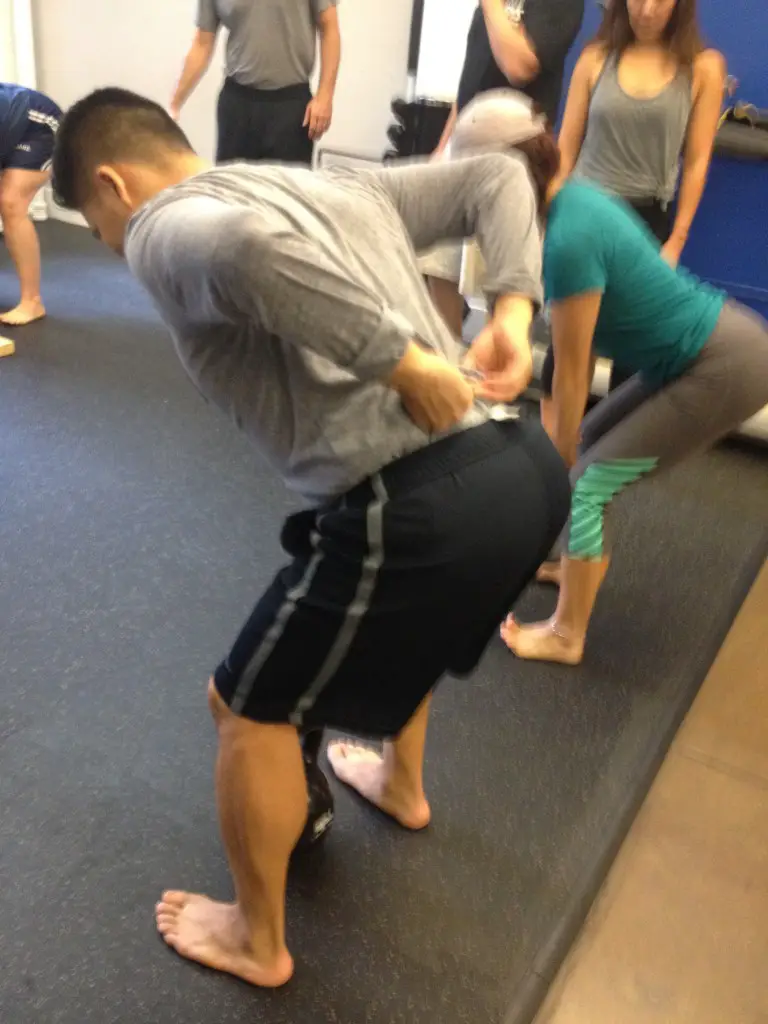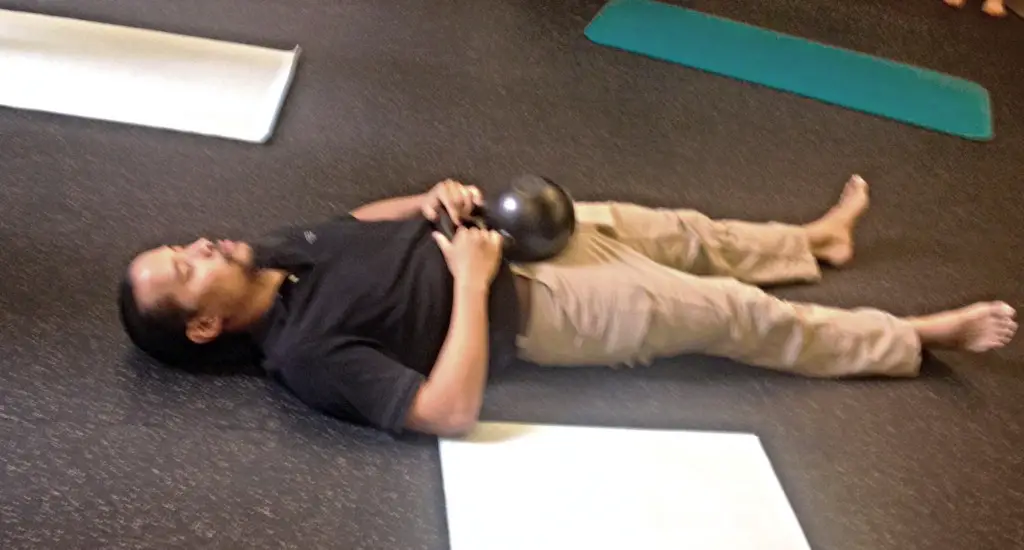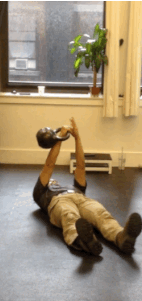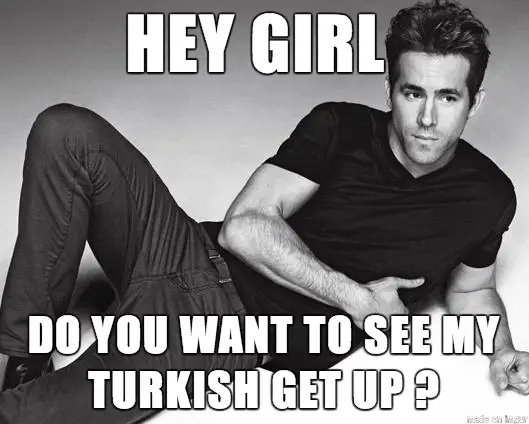On August 2 and 3rd I was lucky enough to part take in Mark Cheng’s Prehab-Rehab 101 workshop at Perfect Stride in NYC. This was not only a special event because of the instructor and content, but it was the smallest class size I’ve ever been in. There were only 13 other clinicians in the class. Having this much of Mark’s attention provided for a great learning experience.
Mark Cheng is an awesome instructor. He is extremely humble, gracious, and open minded. Mark was very receptive to random clinical questions and let us dictate the flow instead of forcing pre-determined material down our throats at his preferred pace. His teaching style makes you feel like you’re learning from a friend as opposed to authoritative lecturer.
Kinesthetic Lesson
I had just finished reading Pavel’s Naked Warrior a couple weeks before the class. This helped tremendously since Mark was trained by Pavel himself and employs many of his concepts. One of the biggest concepts I learned from Pavel and Mark is the importance of generating TENSION.
As movement practitioners, we often spend a good amount of time worrying about the right load, volume, duration, and kinematics. However, the ability to develop tension is often overlooked. Throughout the course, Mark had us focus on the ability to generate the right amount of tension, from the right places, at the right time.
While this sounds very cumbersome, it wasn’t in practice. To reduce the mental effort and avoid a million different external cues, Mark simply had us slow down the movement. And I mean slow. I used to think I crawled, quadruped rocked, and TGUed at the right pace. But after performing these exercises at such a slow pace, I quickly understood the importance of tension and where it needs to be.
Since taking this course, I’ve found many patients will hide their dysfunctions/compensations with speed and momentum. Slowing people down will reveal their true movement ability.
Foot Priority
The feet make up 25% of the bones of the body. The feet take up a huge amount of real estate in the homunculus. The feet are how the body first communicates with ground. The feet are where we translate the body’s internal force to create a ground reaction force that moves the body in space. Needless to say, the feet are very important.
Mark thinks the feet are one of the most neglected parts of the body. He put a big emphasis on the importance of foot health and having the proper mobility/stability in our body’s most inferior joint.
2 Foot Exercises:
1) Pulling the Toes Up to Create an Arch/Tripod Foot (Stability)
2) Ankle Circles (Mobility)
• Maintain forefoot/toe contact and focus on making slow circles with heel (clockwise & counterclockwise)
Ground Work
Since I started using the developmental sequencing a couple years ago my outcomes have improved dramatically. I was excited to learn more from Mark on this topic and wasn’t disappointed. Mark refined the fundamental details and added a ton of new progressions. These have been very helpful in the clinic.
Groundwork Pearls:
• Breathing – Mark wants the apex of the breath to be low; around the beltline
• The true developmental progression is Breathing – Vision – Head Movement
• Everything is driven with the eyes; from supine lifting your head up to crawling.
• Mark feels vision is very valuable sensory input and is an easy way to progress exercises. For example, to challenge half-kneeling he would simply have people look left and right, then progress it to an “H” pattern (with head movement).
• Since we live in a flexion dominated world, Mark focused on the extension based progressions.
• The Sphinx Progression is awesome
• The “wall crawl” is great regression for patients that cannot get to the ground
Turkish Get-Up (TGU)
Mark Cheng is known for being a leading expert on this subject. So when he was teaching the TGU I was expecting brutal attention to detail, ruthless criticism, and strict kinematics. However, it was the almost opposite experience. Mark just wanted to see good movement. He didn’t worry about exact hand, knee, or foot positioning. He allowed for movement variability.
Mark’s Focus:
1) Avoiding the Hey Girl Posture
• Keeping proper spine alignment and making sure the 4 knots are tied to the true core
2) Going slow and moving with intention
Hip Hinge
Just when I thought there was nothing left to learn with the hip hinge, Mark took my knowledge to another level. This demonstrated once again, the importance of the details when performing the fundamentals.
2 Things I Learned:

The great Peter Hwang of Reset PT demonstrating the greatest tactile cue for the hip hinge. Pause.
1) “Hamstrings at the bottom; Glutes at the top.” Mark had us emphasize pulling down into our hamstrings at the bottom of the position and then creating as much tension with our glutes at the finish position.
2) “What you think you are doing is often different from what you are actually doing”. This was a bummer. I thought I was pretty solid at keeping a neutral spine throughout. It wasn’t until Mark showed us the greatest hip hinge tactile cue of all time that I realized I was losing a little neutrality. Grab your skin at your belt line on your back and hip hinge down. If you lose that skin, you’ve rounded your back.
Manual / Tui-Na
Throughout the course Mark would teach us how he manually gets a “reset” to improve mobility. This was very interesting for me since I have no experience with Chinese manual therapy. It was great not only to learn Tui-Na techniques, but I was able to have Mark perform them on me so I could experience what they were supposed to feel like. One of the things that was really surprising to me was how Mark was able to get these huge cavitations with such little force. It was a very specific, but gentle force. He uses leverage, breathing, and gravity to create the traction and manipulation.
23 Random Goods
1) 5 Asymmetries
• Left to Right
• Top to Bottom
• Anterior to Posterior
• Medial to Lateral
• Internal to External (internal strength;breath,emotions to external strength)
2) The Latissimus Dorsi is also a spinal extensor
3) Self-Myofascial Release (foam roll, etc.) should be performed slowly on a relaxed muscle. You may need to cue or “wiggle” the limb loose.
4) 3 Internal Harmonies
• Emotion with Intention
• Intention with Breath
• Breath with Movement
5) Breathe deep into stomach – below belt line
6) 5 Tensions at the Top of a Hip Hinge
• Foot arch, push through heel
• Knee Extension
• Glutes
• Abs – ribs down
• Open Chest
7) “Context is king”
8) Use manual to bring ease to the area – re-map the brain
9) 4 Knots
• Don’t want it too loose or too tight
• Tie the knots to the right core
• If you shrug your shoulder, you just “tied” the knot to your neck – now your neck and traps have become your “functional core”
10) Releasing rotator cuff can have great impact on neck
11) 4 Biggest High Yield Areas for Release
• Popliteus
• Anterior Thigh (RF, VL)
• Infraspinatus
• Subscapularis
12) Sometimes you need to contract a muscle to teach it to relax. Sometimes you need to relax a muscle to teach it to contract.
13) The hyperextension you often see with a hip hinge, or other movements, comes from the T-L Junction
14) 3 Athletic Movements
• Symmetrical Double Stance
• Split Stance
• Single Leg Stance
15) Getting your head in neutral can increase shoulder flexion ROM
16) “Spread the Chest”, “Keep Chest Wide”, “Open Chest”
• Cue for proper scapula, t-spine, and neck position
• Avoids improper scapula packing
17) “I’d mobilize shaq on his stomach with someone pulling his ankles”
18) 2 Ways the Chinese Keep a Secret
• Tell Nothing
• Tell Everything
19) Night Cramps – check magnesium
20) Fearful / Painful Patients
• Make it playful
• You take away the threat by adding in the fun
• Reaction drills are very engaging, fun
21) Have people walk after interventions. It allows the body to “re-calibrate” the new stimulus
22) 4 Pry’s
• Ball of foot
• Knees Out
• Spread Ischial Tubs
• Open Chest
23) Never assume your patient is relaxed
• Always cue them to relax more during soft tissue mobilization
Bottom Line
One of Mark’s goals was to show us new “access points” for movement interventions. Anyone can make something more difficult, but it takes an expert to make something easier. This course not only provided a plethora of new access points for my patients, but also enriched my current practice. I highly recommend this course with Mark Cheng, especially if it is organized in such a small class size like it was at Perfect Stride. A special thanks to Dan Park for putting this course together.
—
The main reason I do this blog is to share knowledge and to help people become better clinicians/coaches. I want our profession to grow and for our patients to have better outcomes. Regardless of your specific title (PT, Chiro, Trainer, Coach, etc.), we all have the same goal of trying to empower people to fix their problems through movement. I hope the content of this website helps you in doing so.
If you enjoyed it and found it helpful, please share it with your peers. And if you are feeling generous, please make a donation to help me run this website. Any amount you can afford is greatly appreciated.









